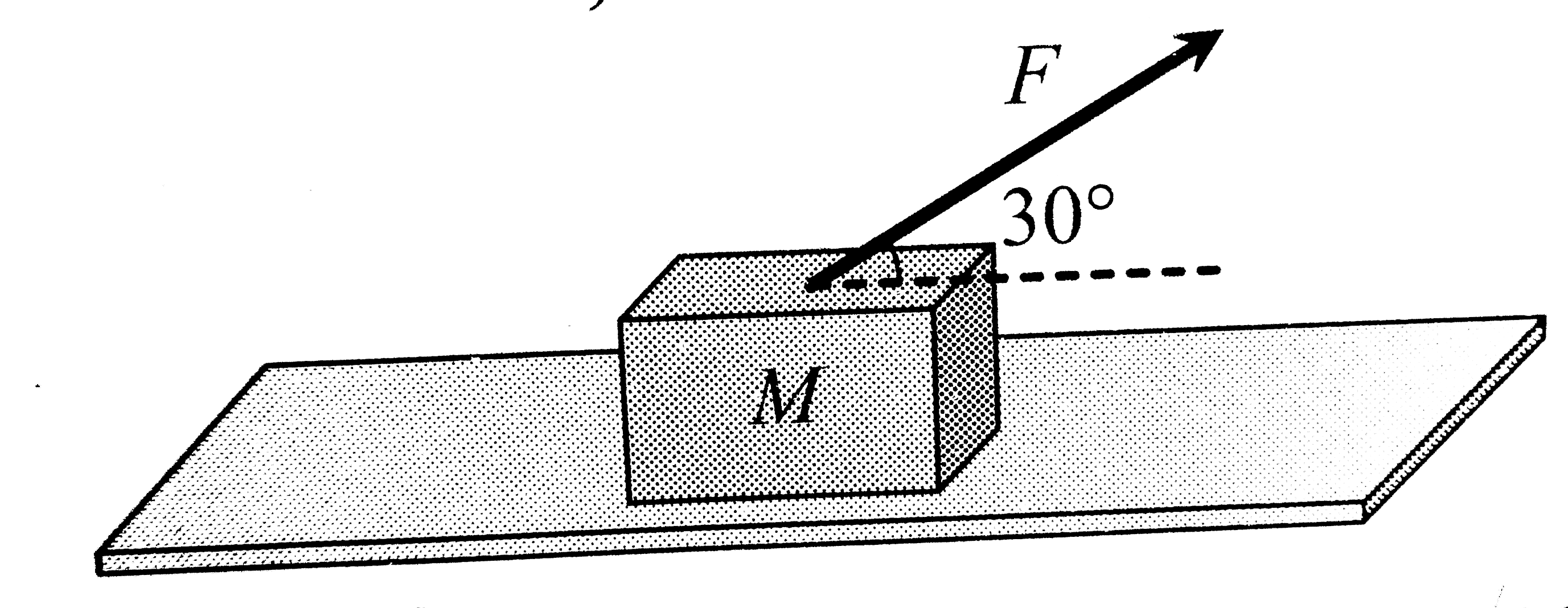A 60 kg weight is dragged on a horizontal surface by a rope upto 2 metres. If coefficient of friction is μ=0.5 the angle of rope with the surface is 60∘and g=9.8m/sec2, then work done is
315.1 J
15 J
588 J
197 J
The correct Answer is:A
To solve the problem step by step, we will follow the physics principles involved in the scenario described.
Step 1: Identify the Forces Acting on the Weight
The forces acting on the weight (mass m=60kg) are:
- The weight of the object, W=mg=60×9.8=588N (acting downwards).
- The normal force R (acting upwards).
- The tension in the rope F (at an angle of 60∘ to the horizontal).
- The frictional force Fk (acting opposite to the direction of motion).
Step 2: Resolve the Tension into Components
The tension F can be resolved into horizontal and vertical components:
- Horizontal component: Fcos(60∘)=F⋅12
- Vertical component: Fsin(60∘)=F⋅√32
Step 3: Apply Newton's Second Law in the Vertical Direction
Since the system is in equilibrium in the vertical direction:
R+Fsin(60∘)=mg
Substituting the values:
R+F⋅√32=588
Thus, we can express R as:
R=588−F⋅√32
Step 4: Calculate the Frictional Force
The frictional force Fk is given by:
Fk=μR
Substituting for R:
Fk=μ(588−F⋅√32)
Given μ=0.5:
Fk=0.5(588−F⋅√32)
Step 5: Apply Newton's Second Law in the Horizontal Direction
In the horizontal direction, the frictional force equals the horizontal component of the tension:
Fk=Fcos(60∘)
Substituting for cos(60∘):
Fk=F⋅12
Step 6: Set Up the Equation
Equating the two expressions for Fk:
0.5(588−F⋅√32)=F⋅12
Multiplying through by 2 to eliminate the fraction:
588−F⋅√32=F
Rearranging gives:
588=F+F⋅√32
Factoring out F:
588=F(1+√32)
Thus:
F=5881+√32
Step 7: Calculate the Value of F
Calculating the denominator:
1+√32≈1+0.866≈1.866
So:
F≈5881.866≈315.8N
Step 8: Calculate the Frictional Force
Now substituting F back to find Fk:
Fk=F⋅12=315.8⋅12≈157.9N
Step 9: Calculate the Work Done
The work done against friction over a distance d=2m:
Work=−Fk⋅d=−157.9⋅2=−315.8J
The magnitude of work done is:
Work=315.8J
Final Answer
The work done is approximately 315.8J.
---
The forces acting on the weight (mass m=60kg) are:
- The weight of the object, W=mg=60×9.8=588N (acting downwards).
- The normal force R (acting upwards).
- The tension in the rope F (at an angle of 60∘ to the horizontal).
- The frictional force Fk (acting opposite to the direction of motion).
The tension F can be resolved into horizontal and vertical components:
- Horizontal component: Fcos(60∘)=F⋅12
- Vertical component: Fsin(60∘)=F⋅√32
Since the system is in equilibrium in the vertical direction:
R+Fsin(60∘)=mg
Substituting the values:
R+F⋅√32=588
Thus, we can express R as:
R=588−F⋅√32
The frictional force Fk is given by:
Fk=μR
Substituting for R:
Fk=μ(588−F⋅√32)
Given μ=0.5:
Fk=0.5(588−F⋅√32)
In the horizontal direction, the frictional force equals the horizontal component of the tension:
Fk=Fcos(60∘)
Substituting for cos(60∘):
Fk=F⋅12
Equating the two expressions for Fk:
0.5(588−F⋅√32)=F⋅12
Multiplying through by 2 to eliminate the fraction:
588−F⋅√32=F
Rearranging gives:
588=F+F⋅√32
Factoring out F:
588=F(1+√32)
Thus:
F=5881+√32
Calculating the denominator:
1+√32≈1+0.866≈1.866
So:
F≈5881.866≈315.8N
Now substituting F back to find Fk:
Fk=F⋅12=315.8⋅12≈157.9N
The work done against friction over a distance d=2m:
Work=−Fk⋅d=−157.9⋅2=−315.8J
The magnitude of work done is:
Work=315.8J
The work done is approximately 315.8J.
Similar Questions
A force of 10N is acting on a block of 20kg on horizontal surface with coefficient of friction μ=0.2. Calculate the work done by the force.
View SolutionA block of mass 50 kg slides over a horizontal distance of 1m. If the coefficient of friction between their surface is 0.2, then work done against friction is (take g=9.8m/s2) :
View Solution
Knowledge Check
A block of mass 1 kg lies on a horizontal surface in a truck. The coefficient of static friction between the block and the surface is 0.6. If the acceleration of the truck is 5m/s2, the frictional force acting on the block is…………newtons.
A10NB5NC2.5ND20NA block of mass 2kg initially at rest moves under the action of an applied horizontal force of 6 N on a rough horizontal surface. The coefficient of friction between the block and surface is 0.1. the work done by friction in 10 s is
A200JB−200JC600 JD−600J
A body of mass 2kg is kept on a rough horizontal surface as shown in the figure. If coefficient of friction is 0.5, find the work done by frictional force in the interval t=0 to t=5sec

View SolutionThe coefficient of friction between two surface is 0.2. The maximum angle of friction is
View SolutionA force of 98 N is just able to move a block of mass 20 kg on a rough horizontal surface. Calculate the coefficient of friction and the angle of friction (g=9.8ms−2).
View SolutionA block of mass 1 kg lies on a horizontal surface in a truck. The coefficient of static friction between the block and the surface is 0.6. If the acceleration of the truck is 5m/s2, the frictional force acting on the block is…………newtons.
View SolutionA block of mass m=5kg is resting on a rough horizontal surface for which the coefficient of friction is 0.2 . When a force F=40N is applied, the acceleration of the block will be (g=10m/s2) .

View SolutionA block of mass 8 kg is sliding on a surface inclined at an angle of 45∘ with the horizontal. Calculate the acceleration of the block. The coefficient of friction between the block and surface is 0.6. (Take g=10m/s2)
View Solution
